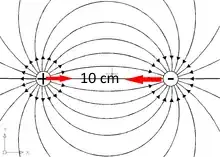In the image you provide,

You have two oppositely charged centers at ten centimeters apart.
If the charge is carried by a solid mass, of dimensions up to $10^{-10}m$, an angstrom, composed of myriads of molecules the classical electrodynamics theory with the Coulomb potential predicts a direct attraction and neutralization , if they are at rest, a "sticking together once the two masses touch.This has not been falsified by experiments. A scattering track can also be predicted and observed with the classical theory.
There is a classical solution of planetary type orbits which has not been observed at the above dimensions because the experiment would be difficult in the gravitational field of the earth.
From ancient times people tried to imagine the smallest possible dimensions for matter. Atom comes from ancient greek philosophy,and it means "something that cannot be further cut", and in the last two centuries it became clear that at angstrom dimensions the classical electromagnetic theory could not work and a new one was needed.
The basic reason is that if the classical theory would extend to the dimensions of the atom , assuming a positive nucleus and a negative electron, the atoms could not exist with the classical theory. The electron would radiate and fall on the nucleus and no chemistry or spectra would exist. Instead there are stable atoms making up the chemistry of the world as we see it. See this answer of mine for a longer explanation and links.
The coulomb potential is used in quantum mechanics to derive the wavefunction of the system under study and it manages to predict the atomic observations where classical theory fails. In quantum mechanics the particles, electron and proton in your question, do not orbit around each other when near enough, but have orbitals, , stable solutions that give the probability of the electron to exist about the proton at an (x,y,z,t) point.
Observations at the angstrom dimensions have to depend on a theory, and the theory is validated and accepted if it can predict the data.
but for a concrete description of what actually happens when a negative charge is released in presence of a positive one
At the quantum dimensions, at low energies, when a positron hits an electron the two particles annihilate and create two photons. If they are energetic enough the energy can be transformed into numerous pairs of elementary particles, which has been studied with the LEP experiments for example.
